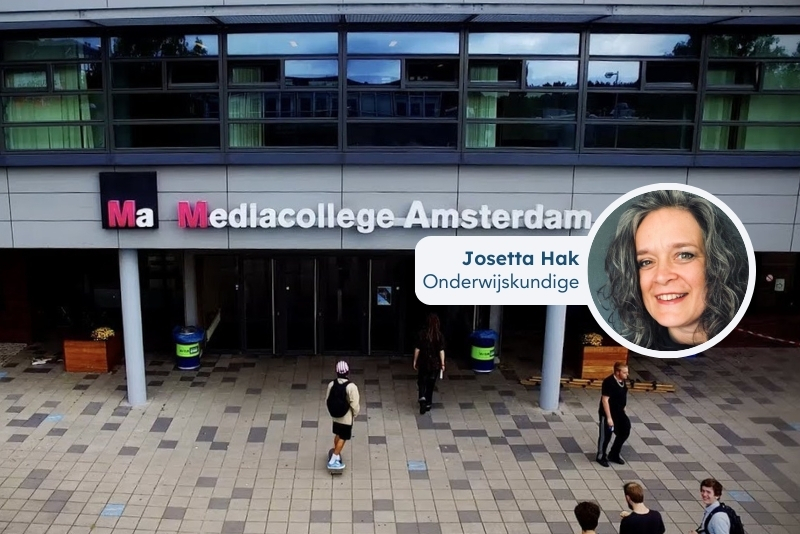Success with Simulise? Discover the Mediacollege’s ‘onboarding’!

‘Onboarding’. That sounds like the settling-in period at your new employer. At the Mediacollege in Amsterdam, it means something different. There, this period is all about being “ready to go with Simulise. But before teams may start using the new system, they must demonstrate that they are ready. So first meet some preliminary requirements.
The result of this approach? A new system for a digital portfolio for students. Josetta Hak, education specialist at Mediacollege, talks about onboarding and how teachers and students experience Simulise.
Many schools need a system that makes student learning visible. Greater understanding of their learning and progress. So does the Mediacollege Amsterdam. “With the advent of Simulise, there is a tool available that makes this possible,” Josetta says. Although implementing “something new” in education is sometimes challenging, it is going extremely well at this MBO school. “We are currently undergoing an implementation in which all fourteen courses are coming ‘on board’ step by step. We are handling this process with precision and policy. “Meanwhile, some teams are already working with it. Their enthusiasm is contagious for the teams that have yet to come on board.”
“I show that it is a user-friendly, is a pleasant tool that makes learning transparent”
A true ‘road show’
And that’s important: involving and informing all teams about implementation. This is exactly why the Mediacollege organizes a true “road show,” in which the project leader visits all the teams together with the application manager. “With this, we show that it is a user-friendly, enjoyable tool that makes learning insightful.” Mediacollege also deploys an iCoach and Key-user during this process. “Short lines of communication with the program manager of each program make all the difference. This creates support and secures the onboarding process,” Josetta states.
Fear Of Missing Out (FOMO) due to onboarding?
Teachers attend training to work with Simulise. “We are super happy that Simulise is very open to different level training. It also doesn’t matter if it’s large teams or small groups of five or six teachers.” Some teachers now know the system so well that they can train colleagues.
Together, they also set up the onboarding for each team. Thus, they discuss the prerequisites for when a course can start working with Simulise. Teams are not allowed to work with Simulise until they “pass” this onboarding. And with that approach, of course, they make the new system desirable(hello FOMO!). “But that’s not the only reason. With proper preparation, you use all the functionalities of Simulise and the system delivers much more,” Josetta adds.
During onboarding, the curriculum and test plan are checked. Also, commitment from the entire team is a must. “Then we look at how the team has set up Simulise. Is that sufficient and can students use it that way? Only then may the team start.”
The experience of students and teachers
At Media College, formative learning and student development is paramount. Simulise’s digital portfolio lends itself well to that, of course. Josetta agrees: “The overview of what students need to do is nice. The interface and looks are social media-like. Teachers and students both experience it that way.”
“The development process and growth of the students is more visible”
They can provide feedback there using rubrics. In this way, students gain insight into what they already do well and what they can improve. This applies to vocational skills as well as soft skills. Thus, “arriving on time” and “working together” are given a clear place in the curriculum. “The development process and growth of the students is more visible this way,” Josetta states. She hopes this understanding will promote student ownership and self-regulation.
From three to fourteen teams
Currently, three teams at the MBO school are already working with Simulise. “In total, we have fourteen courses. All of those have to go through onboarding.” The goal is to have most courses “on board” before the summer break. “So then almost every team can start next school year,” indicates Josetta.
The criteria: what should the digital portfolio meet?
For the Media College, the following criteria were important
“We felt it was important beforehand that our entire education system should be able to fit into it. Our old system only listed the credits. Now we focus on formative action.
Teaching without grades is pretty exciting, so progress has to be really insightful. We wanted a system that supported that. With Simulise, we make the entire development of the student visible. Not only for us, but also for them.”
– A system that incorporates assignments, feedback, rubrics and results
– Making student progress visible
– See at a glance where the student stands
– Usability (not too many click-throughs)
– Interface (it must be pleasing to the eye)
– Students should be able to use the portfolio in their careers, for example, to apply for jobs

